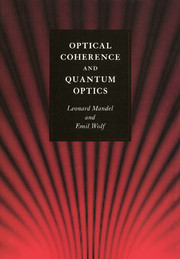Book contents
- Frontmatter
- Contents
- Preface
- 1 Elements of probability theory
- 2 Random (or stochastic) processes
- 3 Some useful mathematical techniques
- 4 Second-order coherence theory of scalar wavefields
- 5 Radiation from sources of any state of coherence
- 6 Second-order coherence theory of vector electromagnetic fields
- 7 Some applications of second-order coherence theory
- 8 Higher-order correlations in optical fields
- 9 Semiclassical theory of photoelectric detection of light
- 10 Quantization of the free electromagnetic field
- 11 Coherent states of the electromagnetic field
- 12 Quantum correlations and photon statistics
- 13 Radiation from thermal equilibrium sources
- 14 Quantum theory of photoelectric detection of light
- 15 Interaction between light and a two-level atom
- 16 Collective atomic interactions
- 17 Some general techniques for treating interacting systems
- 18 The single-mode laser
- 19 The two-mode ring laser
- 20 The linear light amplifier
- 21 Squeezed states of light
- 22 Some quantum effects in nonlinear optics
- References
- Author index
- Subject index
4 - Second-order coherence theory of scalar wavefields
Published online by Cambridge University Press: 05 April 2013
- Frontmatter
- Contents
- Preface
- 1 Elements of probability theory
- 2 Random (or stochastic) processes
- 3 Some useful mathematical techniques
- 4 Second-order coherence theory of scalar wavefields
- 5 Radiation from sources of any state of coherence
- 6 Second-order coherence theory of vector electromagnetic fields
- 7 Some applications of second-order coherence theory
- 8 Higher-order correlations in optical fields
- 9 Semiclassical theory of photoelectric detection of light
- 10 Quantization of the free electromagnetic field
- 11 Coherent states of the electromagnetic field
- 12 Quantum correlations and photon statistics
- 13 Radiation from thermal equilibrium sources
- 14 Quantum theory of photoelectric detection of light
- 15 Interaction between light and a two-level atom
- 16 Collective atomic interactions
- 17 Some general techniques for treating interacting systems
- 18 The single-mode laser
- 19 The two-mode ring laser
- 20 The linear light amplifier
- 21 Squeezed states of light
- 22 Some quantum effects in nonlinear optics
- References
- Author index
- Subject index
Summary
Introduction
We will now study the properties of fluctuating electromagnetic fields, paying attention mainly to the optical region of the electromagnetic spectrum. It seems hardly necessary to stress that every electromagnetic field found in nature has some fluctuations associated with it. Even though these fluctuations are, as a rule, much too rapid to be observed directly, one can deduce their existence from suitable experiments that provide information about correlations between the fluctuations at two or more space-time points.
The simplest manifestations of correlations in optical fields are the well-known interference effects that arise when two light beams that originate from the same source are superposed. With the availability of modern light detectors and electronic circuitry of very short resolving time, other types of correlations in optical fields began to be studied in more recent times. These investigations, as well as the development of lasers and other novel types of light sources, led to a systematic classification of optical correlation phenomena and the complete statistical description of optical fields. The area of optics concerned with such questions is now generally known as optical coherence theory.
The first investigations of coherence phenomena are due to Verdet (1865, 1869) and von Laue (1907a, b). Some early investigations of Stokes (1852) and Michelson (1890, 1891a, b, c, 1892, 1920) although not explicitly mentioning coherence – because this concept is of a much later origin – have also contributed to the clarification and development of this subject.
Information
- Type
- Chapter
- Information
- Optical Coherence and Quantum Optics , pp. 147 - 228Publisher: Cambridge University PressPrint publication year: 1995
Accessibility standard: Unknown
- 3
- Cited by
